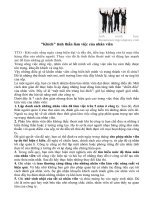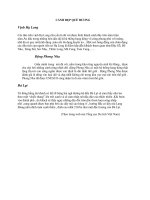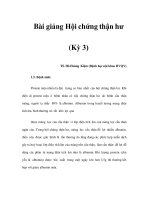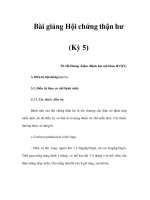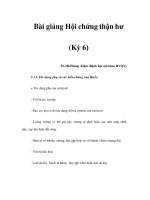Bài giảng neural network Thân Quang Khoát
Bạn đang xem bản rút gọn của tài liệu. Xem và tải ngay bản đầy đủ của tài liệu tại đây (3.8 MB, 69 trang )
Introduction to
Machine Learning and Data Mining
(Học máy và Khai phá dữ liệu)
Khoat Than
School of Information and Communication Technology
Hanoi University of Science and Technology
2020
Outline
¡ Introduction to Machine Learning & Data Mining
¡ Unsupervised learning
¡ Supervised learning
¨
Artificial neural network
¡ Practical advice
2
Artificial neural network: introduction (1)
¡ Artificial neural network (ANN) (mạng nơron nhân tạo)
¡ Simulates the biological neural systems (human brain)
¡ ANN is a structure/network made of interconnection of artificial
neurons
¡ Neuron
¡ Has input/output
¡ Executes a local calculation (local function)
¡ Output of a neuron is charactorized by
¡ In/out characteristics
¡ Connections between it and other neurons
¡ (Possible) other inputs
3
Artificial neural network: introduction (2)
4
¡ ANN can be thought of as a highly decentralized and parallel
information processing structure
¡ ANN has the ability to learn, recall and generalize from the training data
¡ The ability of an ANN depends on
¡ Topology of the neural network
¡ Input/output characteristics
¡ Learning algorithm
¡ Training data
ANN: a huge breakthrough
5
¡ AlphaGo of Google the world champion at Go, 3/2016
¡ Go is a 2500 year-old game.
¡ Go is one of the most complex games
¡ AlphaGo learns from 30 millions human moves,
and plays itself to find new moves
¡ It beat Lee Sedol (World champion)
/> />
6
Structure of a neuron
¡ Input signals of a neuron
{𝑥𝑖 , 𝑖 = 1 … 𝑚}
¡ Each input signal 𝑥𝑖 is
associated with
a weight 𝑤𝑖
¡ Bias 𝑤0 (with 𝑥0 = 1)
¡ Net input is a combination
of the input signals
𝑁𝑒𝑡(𝒘, 𝒙)
¡ Activation/transfer function
𝑓 3 computes the output of
a neuron
¡ Output
𝑂𝑢𝑡 = 𝑓 (𝑁𝑒𝑡 (𝒘, 𝒙))
x0=1
x1
x2
…
xm
w0
w1
w2
Output
(Out)
S
wm
Input (x)
Net
input
(Net)
Activation/
transfer
function
(f)
7
Net Input
¡ Net input is usually calculated by a linear function
m
m
i =1
i =0
Net = w0 + w1 x1 + w2 x2 + ... + wm xm = w0 .1 + å wi xi = å wi xi
¡ Role of bias:
¡ Net=w1x1 may not separate well the classes
¡ Net=w1x1+w0 is able to do better
Net
Net = w1x1
Net
Net = w1x1 + w0
x1
x1
8
Activation function: hard-limited
¡ Also know as a threshold
function
"$ 1, if Net ≥ θ
Out(Net) = HL(Net, θ ) = #
$% 0, otherwise
¡ The output takes one
of the two values
Out(Net) = HL2(Net, θ ) = sign(Net, θ )
¡ q is the threshold value
¡ Disadvantages: discontinuous, non-smoothed (không trơn)
Out
Binary
hard-limiter
Out
Bipolar
hard-limiter
1
1
q
0
Net
q
0
-1
Net
9
Activation function: threshold logic
ì
ï 0, if
Net < -q
ïï
1
Out ( Net ) = tl ( Net, a , q ) = ía ( Net + q ), if - q £ Net £ - q
a
ï
1
ï 1, if
Net > - q
ïî
a
(α >0)
= max(0, min(1, a ( Net + q )))
Out
¡ Also know as a saturating
linear function
¡ Combination of 2 activation
functions: linear and tight limit
¡ 𝛼 determine the slope of the linear
range
¡ Disadvantages: continuous,
non-smoothed (liên tục, nhưng không trơn)
1
-q
0
1/α
(1/α)-q
Net
10
Activation function: Sigmoid
Out ( Net) = sf ( Net, a ,q ) =
1
1 + e -a ( Net +q )
Out
¡ Popular
¡ The parameter 𝛼 determine
the slope
1
0.5
¡ Output in the range of 0 and 1
¡ Advantages
-q 0
Net
¡ Continuous, smoothed
¡ Gradient of a sigmoid function is represented by a function of itself
Activation function: Hyperbolic tangent
11
1 - e -a ( Net +q )
2
Out ( Net) = tanh( Net, a ,q ) =
=
-1
-a ( Net +q )
-a ( Net +q )
1+ e
1+ e
Out
¡ Popular
¡ The parameter 𝛼 determine
the slope
¡ Output in the range of -1 and 1
¡ Advantages
1
-q
0
-1
¡ Continuous, continuous derivative
¡ Gradient of a tanh function is represented by a function of itself
Net
Act. function: Rectified linear unit (ReLU)
𝑂𝑢𝑡 𝑛𝑒𝑡 = max(0, 𝑛𝑒𝑡)
¡ Most popular
¡ Output is non-negative
¡ Advantages
¡ Continuous
¡ No derivative at point 0
¡ Easy to calculate
12
13
ANN: Architecture (1)
bias
¡ ANN’s architecture is determined by
¡ Number of input and output signals
¡ Number of layers
input
¡ Number of neurons in each layer
hidden
layer
¡ Number of connection for each
neuron
output
layer
¡ How neurons (with in a layer,
or between layers) are connected
output
¡ An ANN must have
¡ An input layer
¡ An output layer
¡ No, single, or multiple hidden layers
E.g: An ANN with single hidden layer
• Input: 3 signals
• Output: 2 signals
• Total, have 6 neurons
- 4 neurons at hidden layer
- 2 neurons at output layer
ANN: Architecture (2)
14
¡ A layer (tầng) contains a set of neurons
¡ Hidden layer (tầng ẩn) is a layer between input layer and output layer
¡ Hidden nodes do not interact directly with external environment of the
neural network
¡ An ANN is called a fully connected if outputs of a layer are connected
to all neurons of the next layer
ANN: Architecture (3)
15
¡ An ANN is called a feed-forward network (mạng lan truyền tiến)
if there is not any output of a node being input of another node of the
same layer or a previous layer
¡ When the output of a node is the input of the node the same layer or a
previous layer. It is called a feedback network (mạng phản hồi)
¡ If feedback connects to the input of nodes of the same layer, then it
is called a lateral feedback.
¡ Feedback networks with closed loops are called recurrent networks
(mạng hồi quy)
16
ANN: Architecture (4)
Feed-forward
network
A neuron with
feedback to itself
Recurrent network
with single layer
Feed-forward
network with
multiple layers
Recurrent network
with multiple layers
17
ANN: Training
¡ 2 types of learning in ANNs
¡ Parameter learning: The goal is to adapt the weights of the
connections in the ANN, given a fixed network structure
¡ Structure learning: The goal is to learn the network structure,
including the number of neurons and the types of connections
between them, and the weights
Or
¡ Those two types can be done simultaneously or separately
¡ In this lecture, we will only consider parameter learning
18
ANN: Idea for training
¡ Training a neural network (when fixing the architecture) is learning the
weights w of the network from training data D
¡ Learning can be done by minimizing an empirical error function
L 𝒘 =
!
∑
𝑙𝑜𝑠𝑠(𝑑& , out
|𝑫| 𝒙∈𝑫
𝒙 )
§ Where out(x) is the output of the network, with the input x labeled
accordingly as 𝑑# ; loss is a function for measuring prediction error
¡ Many gradient-based methods:
¡ Backpropagation
¡ Stochastic gradient decent (SGD)
¡ Adam
¡ AdaGrad
x0
x1
x2
…
xm
w1
w2
w0
wm
S
Out
19
Perceptron
¡ A perceptron is the simplest
type of ANNs
(consists of only one neuron).
x0=1
x1
x2
¡ Use the hard-limited activation
function
æ m
ö
ç
Out = sign(Net( w, x) ) = signç å w j x j ÷÷
è j =0
ø
…
xm
w0
w1
w2
wm
¡ For input x, the output value of perceptron
¡ 1 if Net(w,x)>0
¡ -1 otherwise
S
Out
20
Perceptron: Illustration
x1
separation plane
w0+w1x1+w2x2=0
Output = 1
Output = -1
x2
Perceptron: Algorithm
21
¡ Training data D = {(x, d)}
¡ x is input vector
¡ d is output (1 or -1)
¡ The goal of perceptron learning (training) process determines a weight
vector that allows the perceptron to produce the correct output value (-1
or 1) for each data point
¡ For data point x correctly classified by perceptron, the weight vector w
unchanged
¡ If d = 1 but the perceptron produces -1 (Out = -1), then w needs to be
changed so that the value of Net (w, x) increases
¡ If d = -1 but the perceptron produces 1 (Out = 1), then w needs to be
changed so that the value of Net (w, x) decreases
Perceptron: Algorithm
Perceptron_batch(D, η)
Initialize w (wi ← an initial (small) random value)
do
∆w ← 0
for each training instance (x,d)ÎD
Compute the real output value Out
if (Out¹d)
∆w ← ∆w + η(d-Out)x
end for
w ← w + ∆w
until all the training instances in D are correctly classified
return w
22
23
Perceptron: Limitation
¡ The training algorithm for perceptron
is proved to converge if:
¡ Data points are linearly separable
¡ Use a learning rate η small enough
¡ The training algorithm for perceptron
may not converge if data points
are not linearly separable
A perceptron cannot
classify correctly for
this case!
24
Loss function
¡ Consider an ANN that has n output neurons
¡ For data point (x, d), the training error value caused by the (current)
weight vector w:
2
n
1
Ex (w ) = å (d i - Out i )
2 i =1
¡ Training error for the training data D is
1
ED ( w ) =
D
å E (w)
xÎD
x
25
Minimize errors with gradients
¡ Gradient of E (denoted by ∇E) is a vector
æ ¶E ¶E
¶E
ç
ÑE (w) = ç
,
,...,
¶wN
è ¶w1 ¶w2
ö
÷÷
ø
¡ where N is the total number of weights (connections) in the ANN
¡ The gradient ∇E determines the direction that causes the steepest
increase for the error value E
¡ Therefore, the direction that causes the steepest decrease is the
opposite direction to the gradient of E
D𝒘 = −h. Ñ𝐸 𝒘 ;
D𝑤$ =
%&
−𝜂 %'
!
for 𝑖 = 1 … 𝑁
¡ Requirement: all the activation functions must be smoothed
